#christening gowns
Text
Helen Marie handmade christening gowns made in the traditional Irish style using top-quality Irish linen, satin and lace in Galway Ireland. Free delivery worldwide.
Website:
https://helenmarie.ie
Address:
Galboley, Bullaun, Co. Galway H62 X300
Phone Number:
087 629 8754
Contact Mail:
[email protected]
Business Hours:
Monday to Sunday : 9:00 am - 11:59 pm
1 note
·
View note
Text
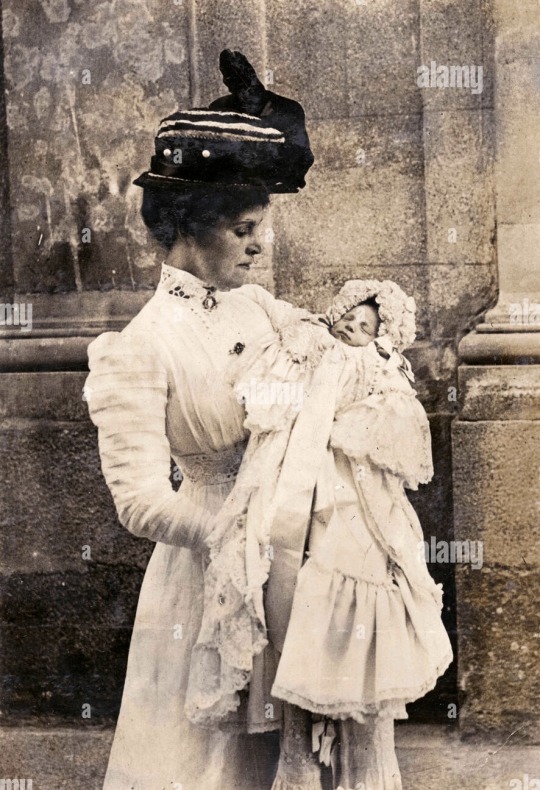
Found this wonderful photo of Baby Infanta Beatriz, being held by her English nurse. The date is unknown but judging by Beatriz’s birth year I believe this to be sometime in 1909.
#spanish royal family#royal baby#infanta Beatriz#I’m not sure if she’s wearing a christening gown??🧐#Borbón
17 notes
·
View notes
Photo
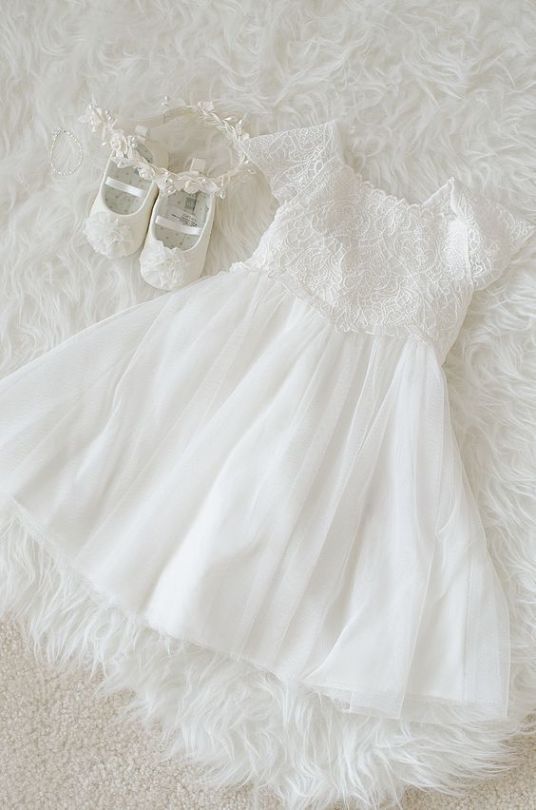
~ White on White ~
14 notes
·
View notes
Text
Shoutout to Past Yubsie for doing something useful for a change! Last time I needed trim it was X for $Y and Past Yubsie decided "At some point I will need white bias tape."
Well guess what I need!
Past Yubsie is NOT forgiven for writing "They come up with a clever plan" on an outline, but she did me a solid on this one.
#the pattern didn't include some of the features i wanted#and then i realized I needed a way to enclose an edge#and bias tape was the obvious solution#and i actually had the right colour in the tote this is great#a convention is a stressful enough deadline#this is a freaking CHRISTENING GOWN
4 notes
·
View notes
Text

A young girl is held by her parents in a church hall. It just so happens that yesterday, the 9th December 2023, was this young girl's naming party. Though it was four and a half months ago she was given life, it was only yesterday that she was given a name!
What will the name of this young girl be?
>Blorbo: Be raised by two homestucks
#blorbo from my uterus#feat the ancestral christening gown made by her great great grandmother#once a homestuck always a goddamn homestuck#roseblogging#literal gpoy#if I'd been planning this gag for as long as lethargyspecialist accused me of yesterday#then I'd have put more time into sprite editing :P
2 notes
·
View notes
Text
God I love ebay... where else can you find beauty and decadance like this....
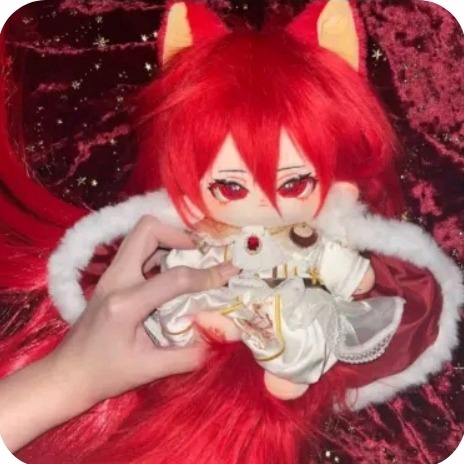
#talking point#i love bootleg merch but the genshin fan produced dolls are so wild#thats not even diluc thats a spirit of wealth and prosperity in his christening gown
5 notes
·
View notes
Photo

The latest addition to my #etsy shop: Baby Christening Gown Slip and Hat Jessica McClintock Simplicity 9386 Uncut Sewing Pattern Sz. NB - 12 Months FREE Mailing To Canada and USA #baptism #sewing #babys #christening #gown #bonnet #pattern #newborn #varioussizes https://etsy.me/3nxZ1IM https://www.instagram.com/p/CfeySvnvJml/?igshid=NGJjMDIxMWI=
4 notes
·
View notes
Text
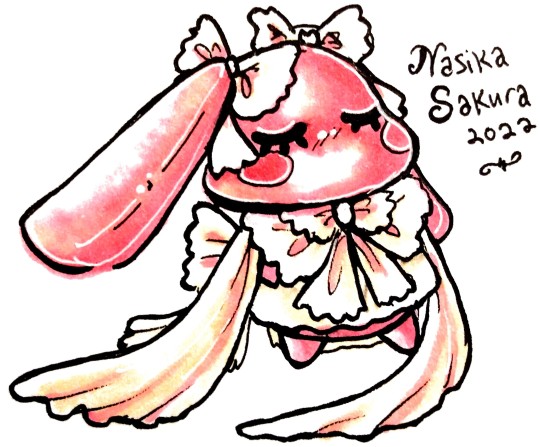
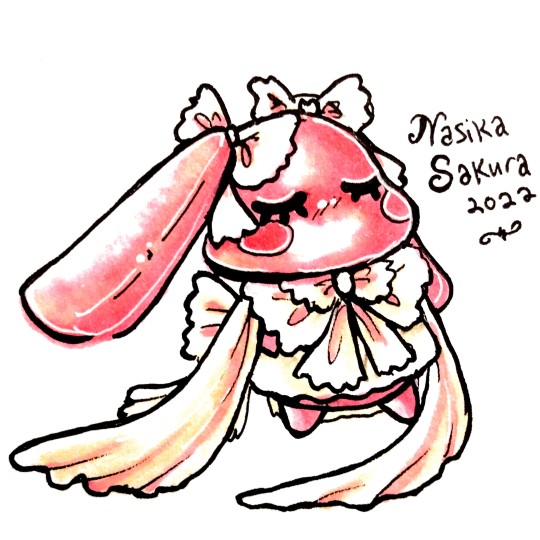

Christening
#bunny#rabbit#bunny art#rabbit art#stuffed animal#plush toy#kawaii#kawaii aesthetic#christening#christening gown#baptism#baptismal gown#white dress#bows#ink drawing#ink illustration#copic art#pink aesthetic#NasikaSakura_Bunny
5 notes
·
View notes
Text

Baby Kids Dress
Baptism Dress
Baptism Dress for Baby Girl
Christening Dress
Baptism Gown
Christening Gown
#Baby Kids Dress#Baptism Dress for Baby Girl#Baptism Dress#Christening Dress#Baptism Gown#Christening Gown
0 notes
Text
i bet daniel craig and rachel weisz are engaged in forms of full time kink we can't even comprehend. like if he leaves even one speck of crust on her tea sandwiches she puts him in a christening gown and hunts him on their estate
16K notes
·
View notes
Text



15 rows in! It will eventually be an infant christening gown.
#I find it ironic that I’m crocheting a christening gown because I wanted a challenging crochet project (it’s actually not that hard) and I h#old the entire process in disdain. but whatever. this is a fun summer project and I’m enjoying watching it take shape#crochet#christening gown
0 notes
Text

Gold and White Christening Gown, Late 18th Century, Austrian.
Kunst Historisches Museum Wien.
#Kunst Historisches Museum Wien#KHMW#18th century#unknown decade#unknown decade 18th century#Austrian#austria#golden#white#child#children#baby#infant#christening gown#Christening
1 note
·
View note
Text

The three genders
Brought to you by my local mall which is dying painfully so it has to allow the worst possible stores
#also on the other wall they were selling rainbow flags and blm flags#actually the store is owned by a very nice man from Senegal and it sells everything from christening gowns to skateboards#im guessing the guy just wnats to appeal to everyone and in doing so appeals to no one
0 notes
Link
The Story Behind Imee Marcos’ Terno
It’s been weeks since her brother’s inauguration, and still, Senator Imee Marcos is making waves. Is it a trending interview? Is it something uploaded on her YouTube channel?
No. It has something to do with the Filipino formal dress she wore on that memorable day, June 30, 2022, as her brother, Bongbong Marcos, took his oath as the 17th President of the Philippines.
While all other women donned Filipiniana gowns from acclaimed and up-and-coming designers, the Presidential sister chose to design one on her own. But while the move showcased the many facets of this Senator, the situation was more symbolic than anything.
The teal Filipiniana gown was created by Rem Divino. However, Imee chose to adorn it with bits and pieces that are very close to her heart. With restored pendants, chains, and lockets that Marcos received as gifts from her father, the late president Ferdinand E. Marcos Sr., the senator embellished the little butterfly sleeve.
The terno, which evolved from the more conventional four-piece traje de mestiza, is already modernized, and the one-sleeved version offers a fresh take on the style. There were “oohs” and “aahs” over her ensemble, not very far from the usual reception that someone close to Imee received from long ago days of glamor in Malacanang.

(Photo courtesy of Esquire Philippines, Article Published on June 30, 2022)
You see, Imee’s mother, former First Lady Imelda Romualdez Marcos’ go-to outfit during the lengthy rule of her husband, Ferdinand, Sr. is the terno. Her relationship with it was solidified with the grace she exuded wearing it, earning the nickname “Iron Butterfly.”
Do we have a new Iron Butterfly in the making? Do we see a rebirth of the terno as a prime fashion symbol of the country?
The terno garment is the only piece of clothing that truly captures the depth of Filipino history and culture. It exudes Filipino pride. With events like the inauguration and other political events in the country, we are gradually starting to see new Filipino designers coming up with and creating fresh new ways to revive the Filipino traditional dresses.
And this has all been enhanced by Imee’s knack for reinvention. Just look at her ensemble. Apart from the heirlooms and gifts, she matched it with a gold-sequined mask and a thick layer of gold bracelets, allowing the opulence of the terno to shine.
History with a hint of modernity.
That’s what some people think of when they look back at what the Pinay Senator wore.
The actual garment is a straightforward, chic, traditionally layered column terno dress. It is lined with a shade of polvoron-colored Regency lace, overlaid with little side panels of hand-loomed materials. Artisans in Batangas meticulously hand-embroidered flowering and budding Sampaguita on the front and back of the frock in the manner of 18th-century Filipino embroiderers utilizing the craftsman method of calado.
Beauty at its finest.
There were many other celebrities during the inauguration, known for their beauty and grace. But the hum is on Imee.
She is not the first lady like her mom was. But she does exude the same kind of power and charm that define the modern Filipina woman.
The modern Filipina woman – this is what the terno is all about.
Youngsters find it hard to appreciate the beauty of the terno dress. But with the likes of Imee Marcos, whose unique spin and fresh take on her outfits, can bring the essence of the terno closer to the younger generation.
Who knows? This ensemble might eventually be a regular fixture at gala celebrations, film festivals, and the like, not just in the Philippines but all over the world. Hopefully, the reinvention of the terno enables both present and future generations to learn new ways to honor and celebrate their own cultures.
(Photo courtesy of Daily Guardian Facebook Page, Post last July 1, 2022)

#pinoypride#filipinos#philippines#shopping#philippine#barongtagalogforwomen#barongsforwomen#barong tagalog#weddingentourage#fhilipina#Designer Gowns#Gowns#christening gown#customgown
1 note
·
View note
Text
Officiants Near Me Ga., Marriage Officiants Near Me Gwinnett, Minister Near Me Wedding, Justice of the Peace Near Me, Sign Marriage License Certificate Near Me, Elopement Chapel Near Me, Sign Courthouse Wedding License, Lawrenceville, Gwinnett County, Dekalb County, Atlanta Georgia Weddings; Wedding Officiants Near Me 2 Best in Georgia (with References); “Best of Gwinnett” 2 Top Wedding Officiants in Lawrenceville Gwinnett County, Ga., How to Find Best Affordable Budget Wedding Officiant in Gwinnett County, Ga., Dekalb County Ga. Wedding Officiants (with Pictures)
770-963-7472
Officiants Near Me, Marriage Officiants Near Me, Minister Near Me Wedding, Justice of the Peace Near Me, Sign Marriage License Certificate Near Me, Elopement Chapel Near Me, Sign Courthouse Wedding License, Lawrenceville, Gwinnett County, Dekalb County, Atlanta Georgia Weddings; Wedding Officiants Near Me 2 Best in Georgia (with References); “Best of Gwinnett” 2 Top Wedding Officiants in Lawrenceville Gwinnett County, Ga., How to Find Best Affordable Budget Wedding Officiant in Gwinnett County, Ga., Dekalb County Ga. Wedding Officiants (with Pictures)
770-963-7472
As Seen on Thumbtack, Endorsed by Atlanta Bridal Magazine, Reverend Thomas Johnson Stars As the Officiant on the Hit Netflix Reality Show “Love Is Blind”
ATLANTA WEDDING MINISTERS OFFICIANTS JUSTICE OF PEACE MARRY ELOPE GEORGIA in LAWRENCEVILLE
Weddings in LAWRENCEVILLE, GA 770-963-7472 Worldwide – United States – Lawrenceville, GA – Weddings
ATLANTA GEORGIA WEDDING OFFICIANTS,…

View On WordPress
#AISLE#BESTMAN#BILINGUAL#bridal GOWN#BRIDE#BUDGET#CELEBRITY#CEREMONY#CHAPELS#CHAPLAIN#CHRISTEN#CHURCHES#COUNSELING#COURTHOUSE#funerals#georgia#God#groom#GWINNETT#Gwinnett County Courthouse#Hispanic#judges#Justice of the Peace Georgia ATLANTA#justiceofpeace#license#limo#marriage#marry#ministers#OFFICIANT
0 notes
Text
Pink is for Boys
"Pink or Blue? Which is intended for boys and which for girls? This question comes from one of our readers this month, and the discussion may be of interest to others. There has been a great diversity of opinion on this subject, but the generally accepted rule is pink for the boy and blue for the girl. The reason is that pink, being a more decided and stronger color, is more suitable for the boy, while blue, which is more delicate and dainty, is prettier for the girl." ~ The Infants' Department, June 1918


[Left: The Blue Boy, oil on canvas, c. 1770, by Thomas Gainsborough.
Right: The Pink Boy, oil on canvas, c. 1782, by Thomas Gainsborough.]
Pink is for girls and blue is for boys. But it hasn't always been this way. Colour coding infants as a way of denoting gender was popular in 20th century America. The problem? Pink and blue? Which is for boys and which is for girls?
In 1927 TIME Magazine asked ten of the "leading stores that sell baby equipment" which colour was for which gender. Four stores responded pink for girls and blue for boys; Macy's (Manhattan), Franklin Simon (Manhattan), Wanamaker's (Philadelphia) and Bullock's (Los Angeles). Five stores responded pink for boys and blue for girls; Best's (Manhattan), Marshall Field's (Chicago), Filene's (Boston), Maison Blanche (New Orleans) and The White House (San Francisco). Curiously Halle's (Cleveland) responded that pink was for both boys and girls.
This debate would continue and it wasn't until mid-20th century that pink for girls and blue for boys became firmly cemented in western culture.
However the idea of colour coding infants dates back to the 19th century. According to La cour de Hollande sous le règne de Louis Bonaparte in 1808 in Holland pink was used to announce the birth of a girl and blue a boy. In March 1856 Peterson's Magazine (Philadelphia, USA) advises that the ribbon on a christening cap should be blue for a boy and pink for a girl. On the 23rd of July 1893 the New York Times writes that for baby clothes it's "pink for a boy and blue for a girl!"

[The Oddie Children, oil on canvas, c. 1789, by William Beechey, via North Carolina Museum of Art.]
During the latter half of the 18th century one of the most popular outfits for young children, regardless of gender, was a white dress with a coloured sash tied around the waist. Pink and blue being the most popular colours, although other colours were worn as well. It would be tempting to assume that the colour of the sash indicated gender but there isn't clear evidence that this was the case. The Oddie Children (above) depicts Sarah, Henry, Catherine, and Jane Oddie. The three girls are all wearing white dresses; two with a blue sash one with a pink sash. We also see Henry Russell (bellow left) wearing a blue sash and Prince William (bellow right) wearing a pink sash.
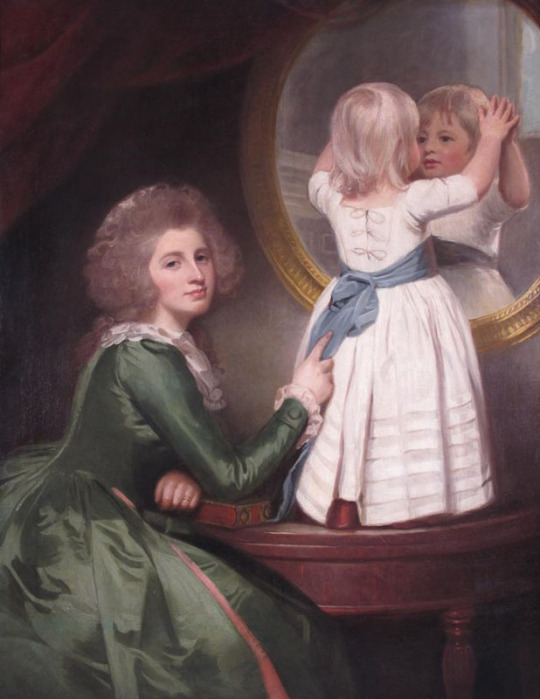
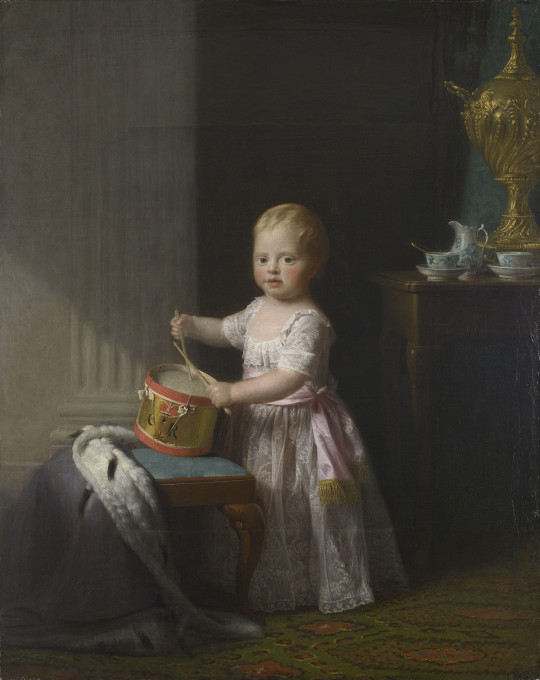
[Left: Anne Barbara Russell née Whitworth with her son Sir Henry Russell, oil on canvas, c. 1786, by George Romney, via Woolley & Wallis.
Right: Prince William, oil on canvas, c. 1767, by Allan Ramsay, via the Royal Collection Trust.]
Pink was just one of the many colours popular in 18th century English womenswear and seems to have stayed popular throughout the century. On the 3rd of January 1712 The Spectator published an article in which a man recalls seeing "a little Cluster of Women sitting together in the prettiest coloured Hoods that I ever saw. One of them was Blew, another Yellow, and another Philomot; the fourth was of a Pink Colour, and the fifth of a pale Green". On the 1st of May 1736 the Read's Weekly Journal, or British Gazetteer reports that the ladies attending the royal wedding wore gowns of "Gold stuffs, or rich Silks with Gold or Silver Flowers, or Pink or White Silks, with either Gold or Silver Netts or Trimmings;" shoes either "Pink, White or Green Silk, with Gold or Silver Lace and braid all over." On the 24th of May 1785 Charles Storer writes to Abigail Adams advising that fashionable colours in English court dress are "pink, lilac, and blue" such "as is worn at Versailles".
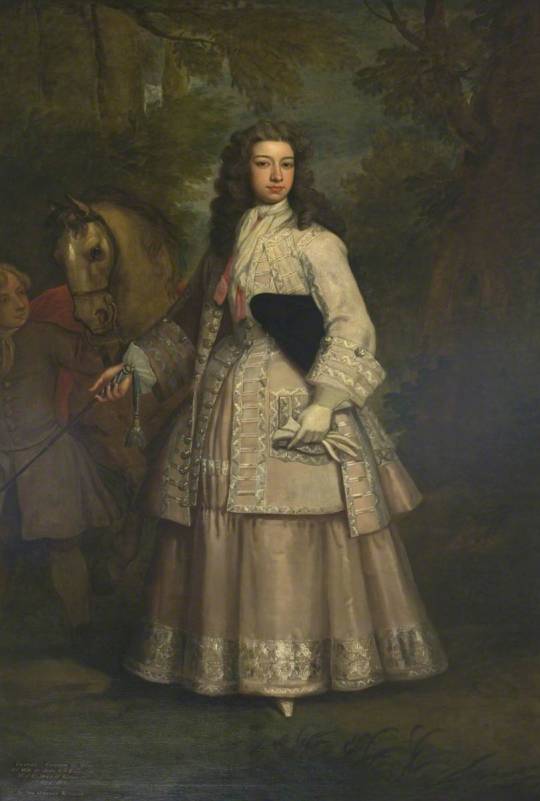
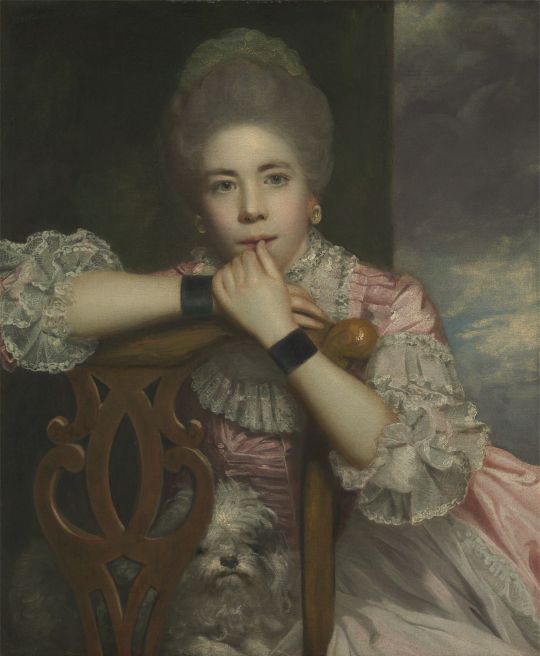
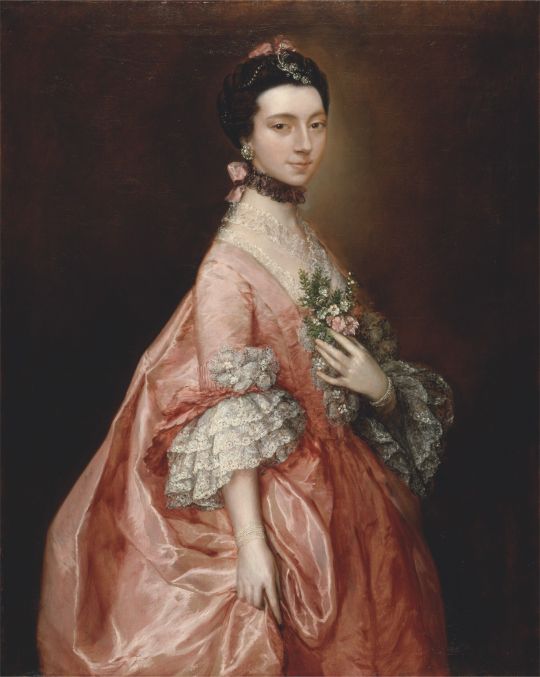
[Left: Frances, Daughter of Evelyn Pierpont, 1st Duke of Kingston, oil on canvas, c. 1700-23, by Godfrey Kneller, via Art UK.
Middle: Mrs. Abington as Miss Prue in "Love for Love" by William Congreve, oil on canvas, c. 1771, by Sir Joshua Reynolds, via Yale Center for British Art.
Right: Mary Little, later Lady Carr, oil on canvas, c. 1765, by Thomas Gainsborough, via Yale Center for British Art.]
In particular pink was popular amongst young women as the colour was associated with youth. Older women who wore pink were mocked as vain for dressing in a way that was seen as improper for their age. On the 31st of January 1754 Lady Jane Coke writes to Mrs. Eyre criticising old women who wear pink:
As for fashions in dress, which you sometimes inquire after, they are too various to describe. One thing is new, which is, there is not such a thing as a decent old woman left, everybody curls their hair, shews their neck, and wears pink, but your humble servant. People who have covered their heads for forty years now leave off their caps and think it becomes them, in short we try to out-do our patterns, the French, in every ridiculous vanity.
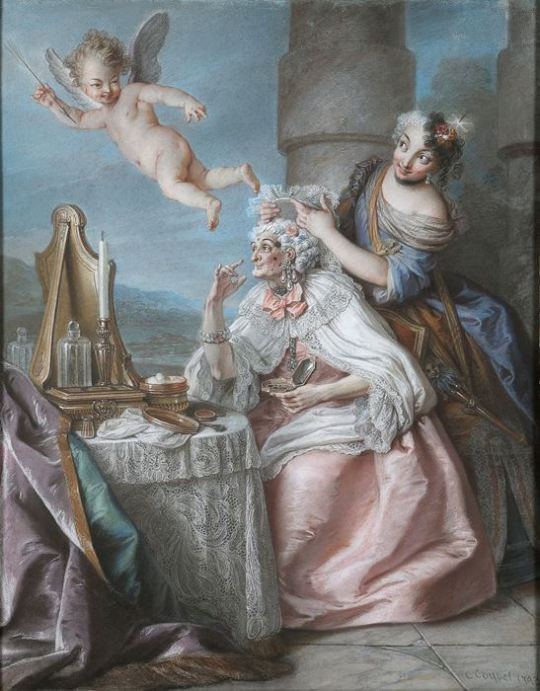
[Folly Embellishing Old Age With the Adornments of Youth, oil on canvas, c. 1743, by Charles-Antoine Coypel, via Master Art.]
For Englishmen acceptable clothing way much more limited. In A Foreign View of England in the Reigns of George I & George II Monsieur César de Saussure writes that Englishmen "do not trouble themselves about dress, but leave that to their womenfolk". He explains:
Englishmen are usually very plainly dressed, they scarcely ever wear gold on their clothes; they wear little coats called "frocks," without facings and without pleats, with a short cape above. Almost all wear small, round wigs, plain hats, and carry canes in their hands, but no swords. Their cloth and linen are of the best and finest. You will see rich merchants and gentlemen thus dressed, and sometimes even noblemen of high rank, especially in the morning, walking through the filthy and muddy streets.
César de Saussure warns that "a well-dressed person in the streets, especially if he is wearing a braided coat, a plume in his hat, or his hair tied in a bow, he will, without doubt, be called "French dog" twenty times perhaps before he reaches his destination" and is not only at risk of "being jeered at" but also "being bespattered with mud, but as likely as not dead dogs and cats will be thrown at him."
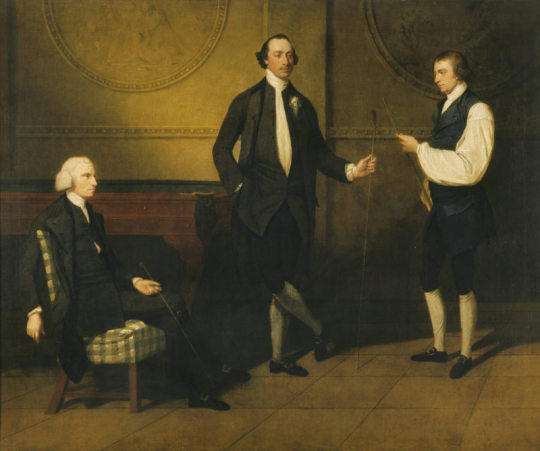
[Reverend Charles Everard Booth, Captain Griffith Booth, and an Unidentified Man playing Billiards, oil on canvas, c. 1775-9, by John Hamilton Mortimer, via the Royal Collection Trust.]
For Englishmen dressing "plainly" mostly meant wearing blacks and browns. In his book on macaroni, Pretty Gentleman, Peter McNeil found that in contrast most English menswear that he describes as generally consisting of "monochrome broadcloth" macaroni wore a variety of colours including green, orange, yellow, violet, red, white, blue, gold, silver and of course pink.
But it's not just the macaroni of the 1770s & 1780s that wore pink. We see pink in descriptions of feminine men's dress (both real and fictional) throughout the 18th century.
On the 2nd of June 1722 Sarah Osborn writes to Robert Byng:
I believe the gentlemen will wear petticoats very soon, for many of their coats were like our mantuas. Lord Essex had a silver tissue coat, and pink color lutestring waistcoat, and several had pink color and pale blue paduasoy coats, which looked prodigiously effeminate.
On the 18th of October 1729 the Universal Spectator and Weekly Journal published a story where an "effeminate" man's clothes were described as follows:
He had a flower'd pink-colour Silk Coat, with a Green-Sattin Waistcoat lac'd with Silver. Velvet Breeches, Clock'd Stockings the Colour of his Coat, Red-heel'd Pumps, a Blue Ribbon at the Collar of his Shirt, and his Sword-Hilt he embrac'd under the Elbow of his Left Arm,

[Sir Miles Stapylton, 4th Bt of Myton, oil on canvas, c. 1730-35, via Art UK.]
In The Adventures of Roderick Random (1748) the effeminate (and queer coded) Captain Whiffle is described as follows:
our new commander came on board in a ten-oared barge, overshadowed with a vast umbrella, and appeared in everything the reverse of Oakum, being a tall, thin young man, dressed in this manner: a white hat, garnished with a red feather, adorned his head, from whence his hair flowed upon his shoulders, in ringlets tied behind with a ribbon. His coat, consisting of pink-coloured silk, lined with white, by the elegance of the cut retired backward, as it were, to discover a white satin waistcoat embroidered with gold, unbuttoned at the upper part to display a brooch set with garnets, that glittered in the breast of his shirt, which was of the finest cambric, edged with right Mechlin: the knees of his crimson velvet breeches scarce descended so low as to meet his silk stockings, which rose without spot or wrinkle on his meagre legs, from shoes of blue Meroquin, studded with diamond buckles that flamed forth rivals to the sun! A steel-hilted sword, inlaid with gold, and decked with a knot of ribbon which fell down in a rich tassel, equipped his side; and an amber-headed cane hung dangling from his wrist. But the most remarkable parts of his furniture were, a mask on his face, and white gloves on his hands, which did not seem to be put on with an intention to be pulled off occasionally, but were fixed with a curious ring on the little finger of each hand.

[Henry Ingram, 7th Viscount Irwin and His Wife Anne, oil on canvas, c. 1745, by Philippe Mercier, via Art UK.]
On the 28th of July 1780 the London Courant reports:
A few days ago, a Macaroni made his appearance in the Assembly-room at Whitehaven, in the Following dress: a mixed silk coat, pink sattin waistcoat and breeches, covered with an elegant silver nett, white silk stockings with pink clocks, pink sattin shoes and large pearl buckles, a mushroom coloured stock, covered with a fine point lace; his hair dressed remarkably high, and stuck full of pearl pins.
On the 6th of August 1792 The Weekly Entertainer published Sketches and Portraits form the Life by Simon Tueopnrastus which included the following description:
Mercator was a youth of some genius and expectation, but by a strange perverseness of disposition, notwithstanding the extreme natural stiffness of his limbs, he had acquired an early attachment to the most finical and effeminate finery; so that, while yet a boy, he would exhaust every expedient of a fertile invention to procure a laced waistcoat, or the most foppish toy; would dangle a watch-string, with brass seals, from each fob, at a time when the frugal care of his parents would not permit him to wear a watch in either; and would strut in a fine pair of second-hand pink silk breeches, and a light blue coat, with all the formal dignity of—a soldier upon the parade.


[Left: Thomas King in "The Clandestine Marriage", oil on canvas, c. 1792, by Samuel De Wilde, via Yale Center for British Art.
Right: Edward Payne, oil on canvas, by Arthur Devis, via Art UK.]
While pink is mentioned in these descriptions of feminine men's dress it's not singled out as the girl colour the way pink would become in the 20th century. I would argue pink is seen as effeminate not because pink is a uniquely feminine colour but because it was used in fashionable dress. In 18th century England being interested in fashion was seen as an frivolous female trait. Men who showed too much interest in fashion were mocked and ridiculed for their gender nonconformity. "A Man must sink below the Dignity of his Nature, before he can suffer his Thoughts to be taken up on so trivial an Affair, as the Chosing, Suiting, and Adjusting the Adornments of his Person," complains a letter published on the 8th of May 1731 in Read's Weekly Journal, or British Gazetteer:
Decency of Garb ought inviolably to be preserved; nor can there be possibly an Excuse for Dressing like a Merry-Andrew: Rich and coloured Silks are in themselves effeminate, and unbecoming a Man; as are, in short, all Things that discover Dress to have been his Study 'Tis in vain for a Fop of Quality, to think his Title will protect him.


[Left: Madame de Pompadour (detail), oil on canvas, c. 1756, by François Boucher, via Alte Pinakothek.
Right: Elizabeth Wrottesley, later Duchess of Grafton, oil on canvas, c. 1764-5, by Thomas Gainsborough, via National Gallery of Victoria.]
English fashion was highly influenced by French fashion. A popular colour scheme in French fashion was green and pink. A famous example of this colour pairing can be seen in François Boucher's portrait of Madame de Pompadour (above left), she is depicted in a green gown with pink bows and flowers. You can see and example of how this style inspired English fashion in Thomas Gainsborough's portrait of Elizabeth Wrottesley (above right), who is depicted in a green gown with a floral pattern adorned with pink, white and green striped bows.
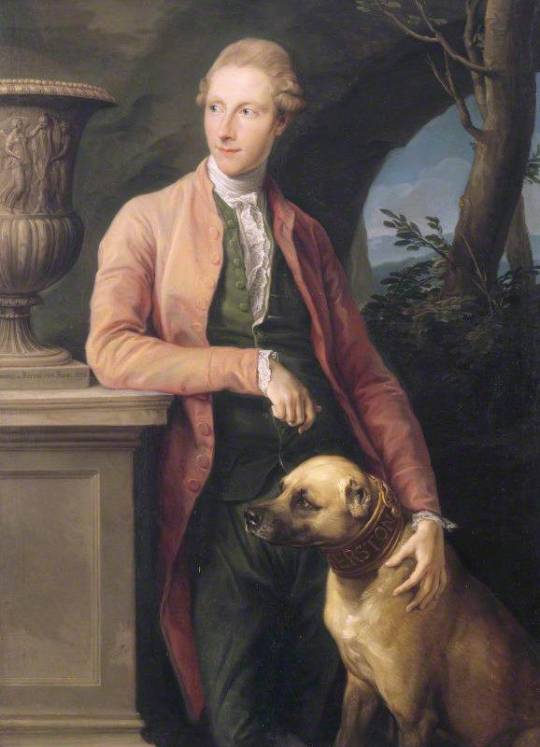
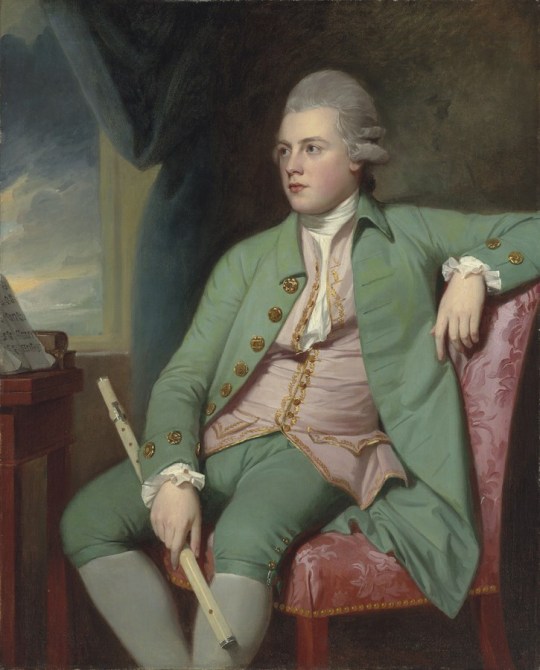
[Left: Sir Harry Fetherstonhaugh, oil on canvas, c. 1776, by Pompeo Batoni, via Wikimedia.
Right: Francis Lind, oil on canvas, c. 1775, by George Romney, via Mackinnon Fine Art.]
Fashionable Englishmen were also inspired by these French designs. Horace Walpole refers to the popularity of the colour combination writing to Lady Ossory on the 19th of February 1774 "If I went to Almack's and decked out my wrinkles in pink and green like Lord Harrington, I might still be in vogue". Almack's is referring to Almack's Assembly Rooms on Pall Mall which is believed to be the inspiration for the Macaroni Club. (see Pretty Gentleman by Petter McNeil p52-55) In a letter to Lord Harcourt on the 27th of July 1773 Walpole writes of "Macaronis lolling out of windows at Almack's like carpets to be dusted."
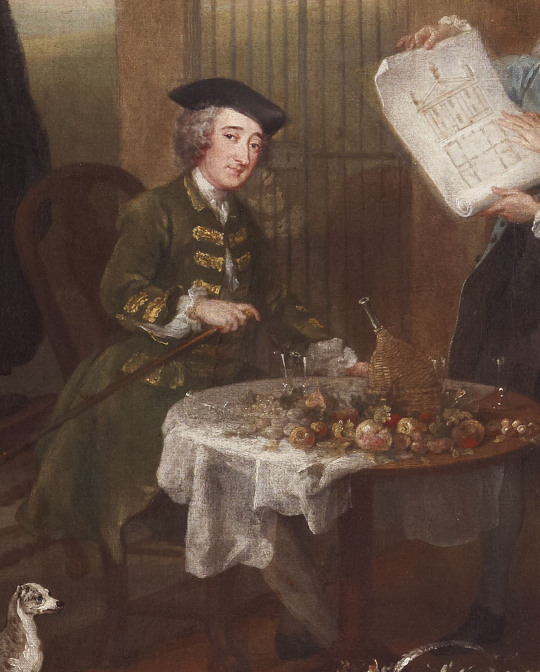

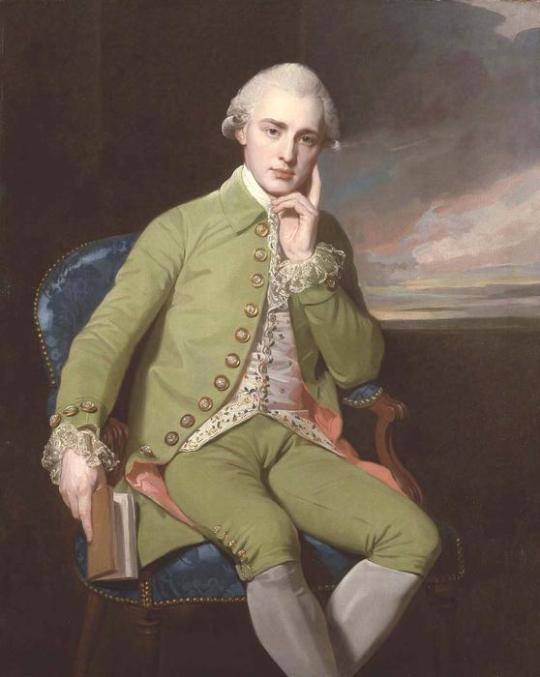
[Left: Detail of Stephen Fox from The Hervey Conversation Piece, oil on canvas, c. 1738-40, by William Hogarth, via Fairfax House.
Middle: Sir William Jones, oil on canvas, c. 1769, by Francis Cotes, via Art UK.
Right: Portrait of a Gentleman, oil on canvas, by George Romney.]
Men who wore green seem to have been just as much, if not more, at risk of being ridiculed, or even assaulted, for the colour of their clothes as those who wore pink. In Pierre Jean Grosley's A Tour to London (originally published 1772) he recalls traveling with a young English surgeon who was harassed by Londoners due to his green French frock coat:
At the first visit which he paid me in London, he informed me, that, a few days after his arrival, happening to take a walk thro' the fields on the Surry side of the Thames, dressed in a little green frock, which he had brought from Paris, he was attacked by three of those gentlemen of the mobility, who, taking him for a Frenchman, not only abused him with the foulest language, but gave him two or three slaps on the face: "Luckily, added he in French, I did not return their ill language; for, if I had, they would certainly have thrown me into the Thames, as they assured me they would, as soon as they perceived I was an Englishman, if I ever happened to come in their way again, in my Paris dress."
230 notes
·
View notes